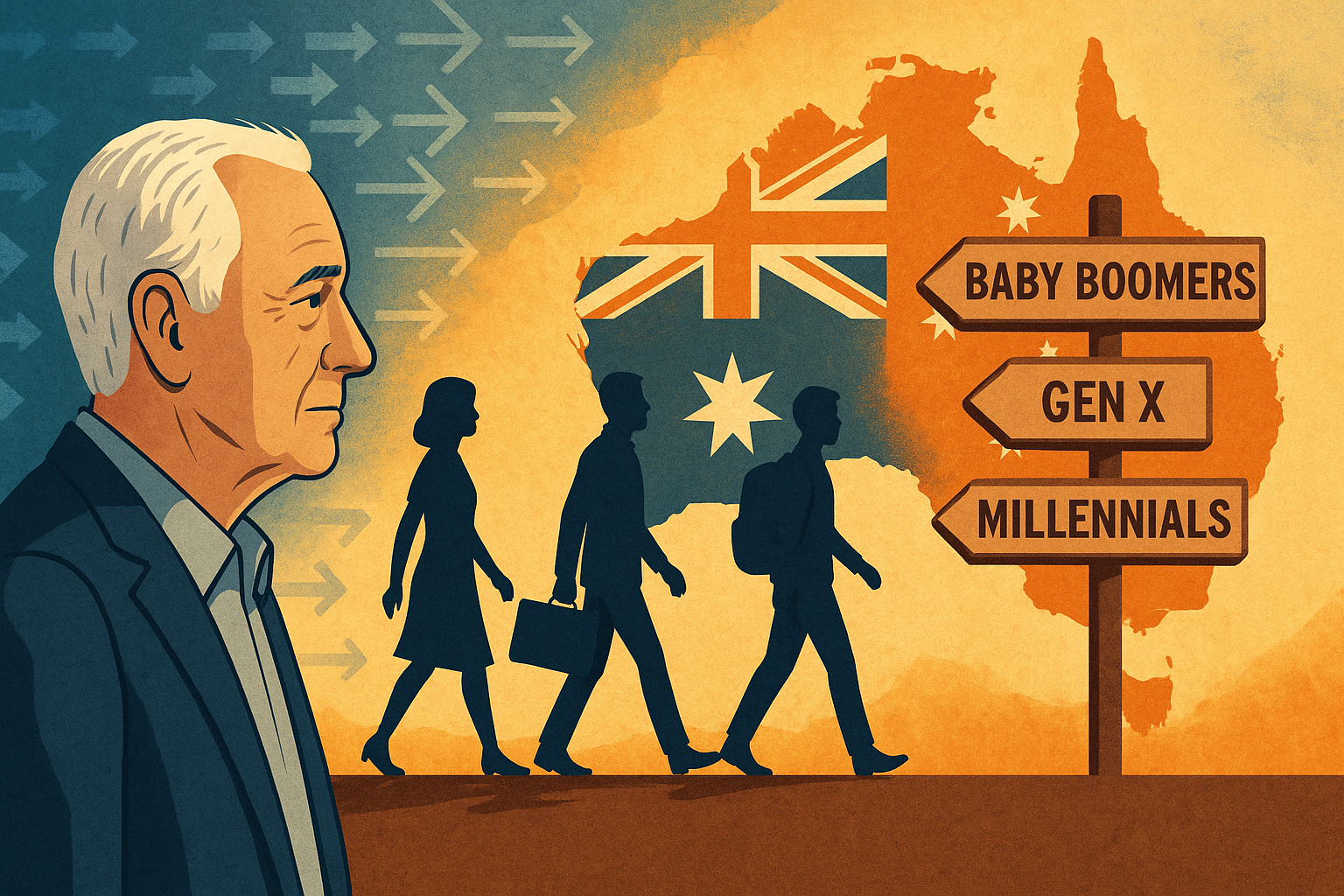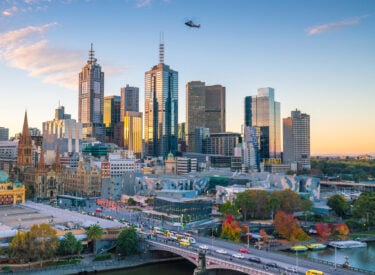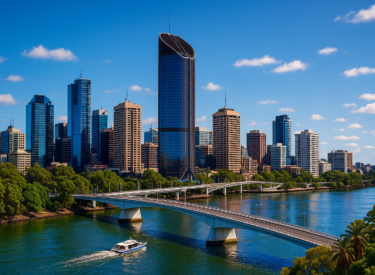
Key takeaways
Over the next decade, millions of baby boomers (born 1946–1964) will retire, taking with them decades of skills, leadership, and entrepreneurial know‑how.
This is more than just replacing workers, it’s a “leadership cliff” that will ripple across industries, regions, and government.
Gen X, the next in line, is smaller in number, meaning mid‑level and senior leadership gaps will open quickly.
Without proactive planning, Australia risks skill shortages, leadership gaps, and regional decline.
The coming transition is also an opportunity to rethink leadership models, workforce planning, and migration policy for a future‑ready economy.
As Simon Kuestenmacher says, this is a rare moment to be bold — the next generation could reshape Australia as profoundly as the baby boomers did.
Australia is standing at a demographic and economic fork in the road.
Over the next decade, millions of baby boomers - the post-war generation born between 1946 and 1964 - will leave the workforce.
We’re not just talking about a few quiet retirements and goodbye morning teas.
What’s unfolding is an unprecedented exit of skill, leadership, experience, and entrepreneurial spirit, and the effects will ripple across every industry, every region, and every level of government.
While this is no surprise, we’ve known for decades that the baby boomers would eventually age out, and we’ve done relatively little to prepare.
And that’s a problem.
As demographer Simon Kuestenmacher puts it in our latest Demographics Decoded episode, “Baby boomers are leaving behind more than empty chairs — they’re leaving behind decades of irreplaceable know-how. And right now, we’re not ready.”
For weekly insights subscribe to the Demographics Decoded podcast, where we will continue to explore these trends and their implications in greater detail.
Subscribe now on your favourite Podcast player:
The knowledge and leadership void
One of the common misunderstandings in the broader conversation is assuming this transition is just about numbers - retire one person, hire another.
But in reality, it’s far more complex.
Baby boomers have dominated senior roles in business, government, education, healthcare, manufacturing, transport, and agriculture for decades.
They’ve built institutions, led teams, and navigated complexity.
Their absence creates a “leadership cliff.”
What makes this more challenging is that the generation following them, Gen X, is numerically smaller.
So businesses can’t simply replace a boomer with a peer-aged successor.
Many Gen Xers will be pushed upward into senior roles, perhaps a win for them, but it leaves mid-level gaps behind them.
And the pool of millennials may need to be fast-tracked into leadership before they’re fully seasoned.
Simon warns, “Businesses will have to get comfortable promoting younger people into senior positions earlier than planned. It’s not optional.”
And he explains in our podcast that this isn’t just a people issue, it’s a structural one.
Hierarchies built for a time when people respected the ‘chain of command’ are now being inherited by younger generations who expect access, transparency, and flattened structures.
In our podcast, Simon warns that companies that don’t adapt will lose talent.
The retirement cliff: which industries are most exposed?
Not all sectors will be equally impacted, however, some industries are walking straight toward a retirement cliff.
Simon has developed a model to identify sectors where a disproportionately high share of the workforce is nearing retirement, typically those aged 55–64.
The most affected?
- Healthcare: Already under pressure, about to lose a wave of experienced professionals.
- Education: Teachers and administrators are retiring faster than we can replace them.
- Agriculture: Many older farmers are exiting without successors, leading to consolidation and depopulation of regional towns.
- Transport and logistics: Bus drivers, truck drivers, delivery and freight workers, many are baby boomers.
- Manufacturing and trades: Aged-dominated and under-replenished.
In many of these areas, the situation is compounded by long-term underinvestment in skills training and TAFE, and a cultural bias pushing young people toward university education and white-collar careers.
Today, 80% of Australians finish Year 12, and more than half go on to university, yet we face a dire shortage of plumbers, electricians, bricklayers, aged care workers, mechanics, and drivers.
The migration mistake: we’re not thinking strategically
Migration has long been a pressure valve for our labour market shortages.
But we’ve fallen into the trap of using migration reactively, not strategically.
Simon argues that we need to “weaponise migration”, not just open the doors wider, but target the right skills, prioritise younger migrants, and align visa categories with long-term demographic needs.
For example:
- Aged care will double in demand over the next 15 years: we’ll need thousands more carers.
- Construction and trades are crying out for skilled workers, yet our intake doesn’t prioritise trades-based visas.
- Regional areas suffer most acutely, yet migrants tend to settle in the same five cities that already house two-thirds of the population.
“We’re the world’s most urbanised country by concentration,” says Simon. “We live in the same few cities we did 100 years ago. We should be master-planning new regional centres and linking them with fast rail, but we’re not.”
Australia needs a national demographic strategy, a roadmap that explains to the public why migration matters, where migrants should go, what roles they’ll fill, and how we’ll support them with housing and infrastructure.
Without it, we risk both political backlash and policy paralysis.
AI and automation: helpful, but no silver bullet
Some argue that AI and robotics will fill the gaps.
But this is a partial solution at best.
Yes, automation can help in manufacturing, logistics, and even aged care administration.
But as Simon rightly says, “We still need real people to serve meals, stock supermarket shelves, clean offices, and care for our elderly.”
AI won’t mow your lawn, build your extension, or fix your plumbing, not anytime soon.
And it can’t replace the emotional intelligence and contextual understanding that real human workers bring.
In fact, Simon is adamant: “High unemployment in Australia? I find that idea ridiculous. The demand for labour will only grow, and if AI becomes more productive than expected, we can simply reduce our migration intake.”
The Boomer business sell-off: opportunity and risk
Beyond employment, baby boomers also dominate small business ownership.
- There are 1.7 million self-employed Australians.
- Nearly 1 million are sole traders with no staff, essentially one-person businesses.
- The rest own businesses with employees: cafés, dry cleaners, tradie businesses, accounting firms, and more.
As these owners age, they’ll want to exit.
That should be an opportunity for younger entrepreneurs to buy in, but access to capital is a problem.
Banks are reluctant to lend to millennials who don’t own property, especially for small business acquisition.
And boomers often overvalue their businesses, making deals harder to close.
Even worse in regional areas, where fewer buyers exist.
Businesses that can’t be sold often just close, reducing local services and increasing market concentration.
Over time, that leads to higher consumer prices and fewer choices.
The golden opportunity for young entrepreneurs
If you're a young Australian with ambition and skills, especially in the trades, this is your moment.
Simon notes that becoming a sole trader (rather than an employee) delivers a 27% income boost on average over a working career.
That’s effectively an extra decade’s worth of wages.
And with a flood of boomers exiting business, there’s a wave of well-established operations, often profitable and with loyal customer bases, that need new owners.
But we need the right policies to support this:
- Succession planning in family businesses.
- Easier access to financing for young buyers.
- Regional business handover schemes.
- Education to prepare young workers for self-employment.
So, where do we go from here?
Here’s the bottom line:
- The workforce is aging and the replacement pipeline isn’t big enough.
- Migration needs to be smarter, not just bigger.
- Businesses need to rethink leadership, structure, and succession.
- Younger Australians need support to step into trades and ownership roles.
Simon sums it up perfectly:
“This is a rare opportunity to rethink how Australia works, to be bold, to prepare properly, and to ensure we hand the next generation not just a stronger economy, but a more adaptable, more future-ready society.”
The baby boomers transformed Australia during their working lives.
The next generation has a chance to do the same if we’re willing to be proactive, not reactive, in how we manage the coming transition.
If you found this discussion helpful, don't forget to subscribe to our podcast and share it with others who might benefit.
Subscribe now on your favourite Podcast player:














